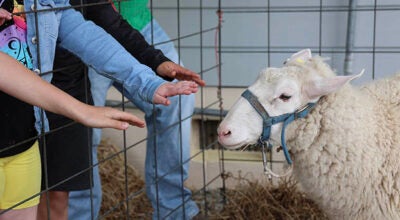Waterworks latest is a ‘story of enduring deceit’
Published 7:04 pm Wednesday, April 24, 2024

- (ALEC HOSTERMAN PHOTOGRAPHY) Cast and Crew of Cat on Hot Tin Roof now playing at Waterworks Players Community Theatre.
|
Getting your Trinity Audio player ready...
|
BY WADE EDWARDS
Special to The Farmville Herald
A story of family secrets and severed relationships, Tennessee Williams’s 1955 Pulitzer Prize winning play, Cat on a Hot Tin Roof, opened last weekend at the Waterworks Theatre on 25 SMI Way, Farmville. With an exquisite cast, splendid direction, and gripping dialog, the performance ranks as one of the Waterworks Players’ finest of the season.
The drama simmers and seethes across three acts, reaching a boiling point before each of the two intermissions, as the Pollitts gather in their Mississippi manor house to celebrate Big Daddy’s 65th birthday. Big Daddy, played by Craig Challender, is a cotton baron unaware that he is dying of cancer. He is the father of dissimilar sons, attorney Gooper (Reeves LaRoche) and former football player Brick (Erik Varela). He is married, unhappily, to the excessively Southern Big Mama (Leigh Lunsford). As often happens when families reunite, delusions are punctured, lies exposed, and feelings fractured.
SETTING THE SCENE
The setting is a large, mid-century bedroom furnished with a vanity, sofa, and wet bar. The décor includes well-chosen artifacts of the period: a turntable and a couple of record albums, a tasteful chandelier, crystal whiskey glasses, silk pajamas. The set also features large windows upstage that look out over a veranda and the wide emptiness of a lawn beyond, evocative of the emotional emptiness of the main characters. The desperation and paranoia of this family reunion are punctuated by sporadic, disquieting cracks of thunder and fireworks that set the audience on edge (ably orchestrated by the sound crew of Paul Maserjian, John Diamond, and director Sean Dowse).
The first act focuses on the unspooling marriage of Brick and his wife Margaret (Sarah Varela), called Maggie the Cat. The couple’s childlessness is the source of both rumor and widespread unhappiness. Frustrated from the beginning, Maggie exclaims that she feels “like a cat on a hot tin roof,” inflamed and trapped by an unrewarding relationship and unsure of how to save herself or her marriage. Brick — broken, disinterested, and alcoholic — short-circuits her attempts at seduction again and again, leaving Maggie to lament: “Living with someone you love can be lonelier than living entirely alone, if the one that you love doesn’t love you.”
Dowse’s blocking in this first act aptly captures the tension of the narrative and the contrasting emotions of the couple. Maggie is almost constantly in motion. By turns vivacious, apprehensive, seductive, and threatening, her movements portray a woman grasping for answers and purpose. Brick, on the other hand, wounded both physically and emotionally, lumbers and lurches about the stage on crutches, moving in a state of manifest depression from bed to chair to settee. His movements are as disjointed and effortful as Maggie’s are feline and fluid. Brick spends time staring aimlessly out the window and hovering at the bar. He trips and falls three or four different times, no longer the athletic hero he used to be. A drink doesn’t leave his hand throughout the play.
COSTUMES ADD A LAYER OF INTEREST
In addition to the noteworthy staging and set dressing, the costumes designed by Geraldine Mongold, Barbara Cone, Sarah Varela, and Maryska Connolly also add a real layer of interest: formfitting dresses, seersucker suits with bow ties, saddle shoes and Colonel Sanders collars, cufflinks and boutonnieres. The Pollitts dress as if they don’t have the problems they do.
The second act is as piercing as the first, as Big Daddy unloads on his wife, revealing his wounds and sense of emasculation. Eventually the act settles on a stilted exposition of mortality and the father-son relationship, of honesty and self-deception, of the hazards of living up to parental expectations and enduring the memories of your elders. In a pivotal moment, Big Daddy expresses the pent-up disappointment of a life of compromise and pretense, declaring, “the human animal is a beast that dies but the fact that he’s dying don’t give him pity for others.” Brick responds, wretchedly, with a summary of the play’s theme: “Mendacity is a system that we live in; liquor is one way out an’ death’s the other.” By the final act, the family is in tatters as new lies supersede old ones and new beginnings seem fruitless. The last line of dialog ends with a bewildering question mark, a fitting end to this story of enduring deceit.
Audience members will appreciate the generous booklet for this production, which includes copious notes — many provided by students of Hampden-Sydney College — that elucidate the themes of the story and provide insights into the characters. In addition to the actors mentioned above, the cast is completed by Melissa Meinhard as Mae, Howard Fischer as Reverend Tooker, James Eggleston as Doctor Baugh, Lilly Reid as Dixie, Evelyn Wright as Trixie, Logan Butwin as Sonny, and Hailey Butwin as Little No-Neck.
WHEN IS THE NEXT PERFORMANCE?
Future performances of Cat on a Hot Tin Roof are planned for 7:30 p.m. on Friday, April 26 and Saturday, April 27. Tickets are available online at waterworksplayers.org or in person at the theatre.



